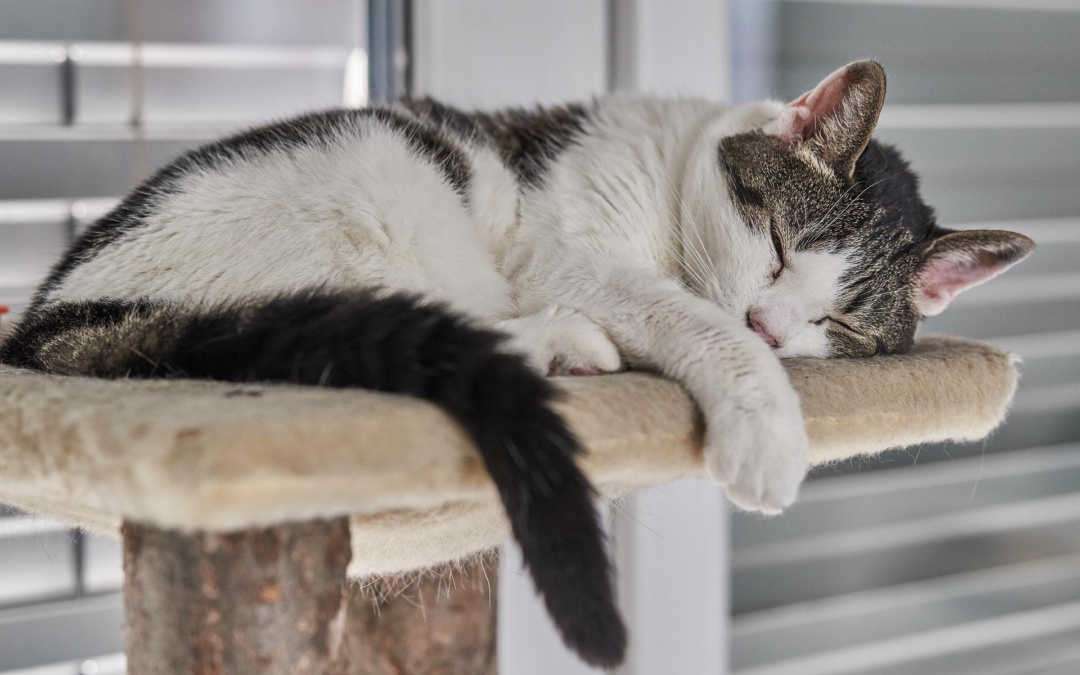If you have a middle-aged or senior cat, your list of worries might be longer than it was a few years ago. Although certain conditions and diseases can find cats of any age, some tend to affect older kitties. Of these, hyperthyroidism is one of the most common.
We begin to consider cats to be seniors at age 6 or 7, and so cat owners need to understand and recognize the signs of hyperthyroidism. Read on to get yourself up to speed.
Understanding Hyperthyroidism in Cats
The thyroid gland is a very important part of the body’s endocrine system. Endocrine organs such as the thyroid, pituitary, and adrenal glands secrete the hormones that must stay in balance for the body to function properly.
The thyroid gland secretes hormones (namely T3 and T4) that are primarily responsible for the body’s metabolism. Most of the time, this gland secretes the proper amount of hormone to keep the body systems functioning normally. Sometimes, however, it secretes too much (hyperthyroidism) or too little (hypothyroidism). The cause of this disease is most commonly functional benign enlargement (adenoma) but about 2% of cases are due to cancer (thyroid carcinoma).
Thyroid hormones affect nearly every organ system in the body, so thyroid disease often causes secondary problems such as heart failure, vision loss, and kidney disease.
Signs and Diagnosis of Hyperthyroidism in Cats
The signs of hyperthyroidism in cats may be subtle at first. You may notice your cat eating and drinking more (and more ravenously), a rough-looking, greasy coat, and weight loss. Some cats also experience digestive disturbances (vomiting or diarrhea) and restlessness. Upon physical exam, your veterinarian will note high blood pressure and an elevated heart rate.
Although hyperthyroidism signs are similar to symptoms of other diseases, it is relatively easily diagnosed with blood pressure testing and a complete blood panel that includes thyroid hormone level tests. Some cats with clinical signs of hyperthyroidism will still have normal levels of thyroid hormone in their blood, so in these cases, further diagnostic testing such as ultrasound will be recommended.
Treatment Options for Hyperthyroidism in Cats
If your cat has been diagnosed with hyperthyroidism, never fear. Your primary veterinarian and the specialists at BEVS work as a team to offer treatment options, and cats who are treated for this disease tend to do very well.
There are four treatment options for hyperthyroidism in cats: medication/diet changes, radioactive iodine therapy, and surgery.
Medication: Anti-thyroid drugs act by reducing the production and release of thyroid hormone from the thyroid gland. The medication, usually in pill form, is not a cure, but rather a treatment that must be given for the remainder of the cat’s life to control the disease. Medication is readily available and inexpensive, but it can cause side effects such as anorexia, vomiting, anemia, or lethargy. Blood tests should be conducted regularly to ensure the medication is working properly and to monitor its effect on kidney function and possible side effects. Dietary management is chosen by some pet owners but should be discussed thoroughly with your veterinarian to minimize side effects.
Radioactive iodine therapy (I-131): This is generally the preferred treatment for cats with hyperthyroidism. During treatment, radioactive iodine is delivered with a single injection. The iodine is taken up by the bloodstream, travels to the thyroid gland, and the emitted radiation destroys the abnormal tissue without damaging the surrounding tissue or parathyroid glands.
Radioactive iodine therapy cures more than 95% of patients within 3 months of therapy and has no serious side effects. It does require the use of a radioactive isotope and is only offered by facilities specifically licensed to administer it, of which BEVS is one. The radioactivity poses no significant risk to the cat, but there are special precautions taken by our staff as required by our license in the administration of the radioactive isotope. Due to the licensing regulations, a treated cat must remain hospitalized with us for 3-5 days until the radiation levels have fallen to acceptable limits.
Surgery: The surgical removal of the thyroid gland eliminates the secretion of thyroid hormone. Surgery requires general anesthesia, which can pose risks for older hyperthyroid cats who have secondary conditions. Surgery also poses the risk of inadvertently damaging the parathyroid glands, which lie close to or inside the thyroid gland and are crucial to maintaining calcium balance in the cat’s body. Medication and radioactive iodine therapy are just as effective at treating hyperthyroidism in cats and pose fewer risks, so surgical intervention is rarely chosen as a treatment for this condition.
At BEVS, we feel fortunate to have the tools and expertise to cure cats with hyperthyroidism using radioactive iodine therapy, and we welcome all questions about this safe and effective treatment. If you have questions about hyperthyroidism in cats or I-131 treatment, please ask your veterinarian for a referral to BEVS, or give us a call.

